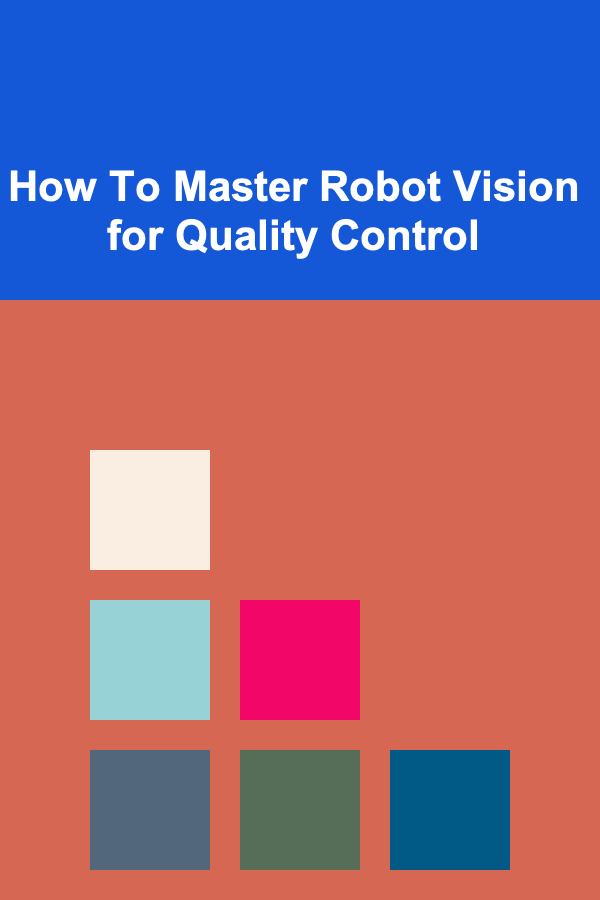
How To Master Robot Vision for Quality Control
ebook include PDF & Audio bundle (Micro Guide)
$12.99$5.99
Limited Time Offer! Order within the next:

In the rapidly advancing world of automation and artificial intelligence, robotic systems have found applications in industries ranging from manufacturing and healthcare to logistics and agriculture. Among these applications, robot vision has become one of the most critical components for ensuring the efficiency and accuracy of industrial processes. As companies continue to strive for higher quality and lower production costs, integrating robot vision into quality control processes is essential.
This article aims to provide a comprehensive guide on mastering robot vision for quality control, examining its foundational principles, key technologies, implementation strategies, and future trends. By the end, you will have a solid understanding of how robot vision can transform quality control in industrial settings and the steps required to harness its full potential.
Understanding Robot Vision and Its Role in Quality Control
Robot vision, often referred to as machine vision, is the ability of a robot to interpret and understand visual information from its environment. In the context of quality control, robot vision systems are used to inspect, measure, and ensure the integrity of products during manufacturing processes.
Key Functions of Robot Vision in Quality Control
- Defect Detection: One of the most important applications of robot vision is identifying defects in products, such as cracks, scratches, discolorations, or improper assembly.
- Measurement and Gauging: Robots can measure dimensions, angles, and tolerances to ensure that products meet the required specifications.
- Sorting and Grading: Robot vision can be used to sort products based on visual characteristics, such as size, color, or shape, to ensure consistency.
- Barcode and Label Reading: Vision systems can scan barcodes or labels to track inventory or verify product data.
- Assembly Verification: Vision systems can check that parts are assembled correctly and in the right orientation, ensuring the proper functioning of products.
With such broad capabilities, robot vision has the potential to revolutionize the way quality control is conducted by making it faster, more accurate, and more cost-effective.
Core Technologies Behind Robot Vision
To truly master robot vision for quality control, it's essential to understand the core technologies that drive these systems. These technologies work together to enable robots to interpret visual data and make decisions based on that information.
1. Cameras and Sensors
The first step in any robot vision system is capturing visual data. This is typically done using specialized cameras and sensors that provide high-resolution images. These cameras may include:
- RGB Cameras: Standard cameras that capture color images.
- Infrared Cameras: Used for detecting heat patterns and temperature differences.
- 3D Cameras: Capture depth information, allowing robots to assess the shape and dimensions of objects.
- X-ray and CT Scanners: In some industries, these technologies are used for non-invasive internal inspections.
The choice of camera or sensor depends on the specific requirements of the quality control process, such as the level of detail required and the environment in which the robot operates.
2. Image Processing Software
Once the images are captured, they must be processed to extract useful information. Image processing software uses algorithms to analyze the visual data and identify patterns, edges, or features in the image. Some key techniques include:
- Edge Detection: Identifying the boundaries of objects in an image, which helps in measuring dimensions or detecting defects.
- Pattern Recognition: Recognizing specific patterns, such as barcodes, logos, or features unique to certain products.
- Blob Analysis: Identifying connected regions in an image that represent physical objects or features.
- Machine Learning: More advanced systems use machine learning algorithms to "learn" from data and improve the accuracy of inspections over time.
3. Artificial Intelligence and Machine Learning
AI and machine learning (ML) are transforming robot vision systems. Traditional systems often relied on pre-programmed rules for detection, but AI-powered systems can adapt and improve based on real-world data. For example:
- Deep Learning: Convolutional neural networks (CNNs) can be trained to recognize complex patterns or classify objects in images.
- Data-Driven Analysis: AI can analyze large volumes of visual data to identify trends, anomalies, or inconsistencies, making the system more adaptive and efficient.
By integrating AI and ML into robot vision, quality control systems can become more flexible and capable of handling complex tasks that were once only achievable by human inspectors.
4. Robotics and Motion Control
For robot vision systems to interact with the physical world, they must be integrated with robotics and motion control technologies. A robot equipped with vision capabilities can perform tasks such as:
- Pick-and-Place: Picking up objects and placing them in specific locations.
- Precise Adjustments: Using vision feedback to correct alignment or positioning of objects during assembly or inspection.
- Sorting: Sorting products based on visual cues like shape or color, often in high-speed environments.
The robot's motion system must be tightly coordinated with the vision system to ensure accuracy and reliability in quality control processes.
Steps to Implement Robot Vision for Quality Control
Implementing robot vision for quality control can be a complex process, requiring careful planning, appropriate technology selection, and integration with existing systems. The following steps outline a general approach to deploying robot vision in a manufacturing environment.
Step 1: Define the Quality Control Objectives
Before implementing robot vision, it is crucial to define the specific goals of the quality control process. These goals might include:
- Detecting a particular type of defect (e.g., scratches, cracks, missing components).
- Ensuring dimensional accuracy and tolerance adherence.
- Improving the speed and efficiency of inspections.
- Reducing human labor costs associated with manual inspections.
Clearly understanding the objectives helps to determine the type of vision system, cameras, and algorithms required for the task.
Step 2: Choose the Right Equipment and Technology
Once the goals are established, selecting the appropriate equipment and technology is the next step. This includes:
- Cameras: Choosing the right camera resolution, frame rate, and sensing technology.
- Lighting: Proper lighting is crucial for obtaining high-quality images. Techniques such as backlighting, diffuse lighting, or structured light may be necessary for different types of inspections.
- Image Processing Software: Choosing software that is capable of performing the necessary analysis, whether that's through traditional algorithms or AI-based systems.
- Robotic Arm or Automation System: Deciding on the type of robot or automation system to use in conjunction with the vision system.
Step 3: Integrate the Vision System with the Production Line
Integration is a critical phase where the robot vision system is connected to the production line and other relevant systems, such as conveyors, machines, and databases. This step involves:
- Calibration: Ensuring that the camera's field of view, lighting, and alignment are properly calibrated.
- Connectivity: Linking the vision system to the robot's motion control system so it can make real-time adjustments based on the visual data.
- Data Handling: Setting up the infrastructure for data processing, storage, and analysis. This includes cloud-based solutions or local servers depending on the complexity of the system.
Step 4: Train the System
Training the vision system is essential, especially when using machine learning or deep learning techniques. The system needs to be exposed to a variety of images, including those with defects, in order to learn to identify the key features of acceptable products. This step may require:
- Supervised Learning: Labeling images manually and training the system to recognize patterns.
- Unsupervised Learning: Allowing the system to find patterns and anomalies without human intervention.
Step 5: Test and Validate the System
Before full deployment, thorough testing and validation are essential to ensure the system's performance meets the required standards. During this phase, the system's accuracy, speed, and robustness should be evaluated. It's important to:
- Test with a variety of product types and defects.
- Measure the system's ability to detect defects at various stages of production.
- Evaluate the system's response time to ensure it meets production speed requirements.
Step 6: Monitor and Maintain the System
Once deployed, ongoing monitoring and maintenance are crucial for ensuring the system remains effective over time. This involves:
- Real-Time Monitoring: Continuously tracking the system's performance and making adjustments as needed.
- Periodic Calibration: Re-calibrating the system to account for any environmental changes or wear on equipment.
- Data Analysis: Analyzing the data collected from the system to identify trends, detect new types of defects, or make process improvements.
Challenges in Mastering Robot Vision for Quality Control
While the potential for robot vision to revolutionize quality control is immense, there are several challenges that need to be addressed:
- Environmental Factors: Variability in lighting, temperature, and other environmental conditions can affect the performance of vision systems.
- Complexity of Defects: Some defects may be difficult to detect with conventional image processing techniques, requiring more advanced AI or machine learning approaches.
- Cost: High-end robot vision systems, particularly those integrating AI, can be expensive to deploy and maintain.
- Integration with Existing Systems: Integrating robot vision into legacy manufacturing systems can be challenging, particularly in older factories with outdated equipment.
The Future of Robot Vision in Quality Control
As technology continues to advance, the future of robot vision for quality control looks promising. Here are some trends to look out for:
- Increased Use of AI and Deep Learning: More systems will rely on deep learning to improve accuracy and adaptability, making robot vision systems smarter and more autonomous.
- Edge Computing: With the growth of IoT, edge computing will allow for faster processing of visual data directly at the source, reducing latency and dependence on cloud systems.
- Collaborative Robots (Cobots): Cobots equipped with vision systems will work alongside human operators, improving the efficiency and flexibility of quality control processes.
Conclusion
Mastering robot vision for quality control is a multifaceted process that involves understanding both the underlying technologies and the practical steps for implementation. With its potential to improve accuracy, speed, and efficiency, robot vision is poised to play a critical role in shaping the future of quality control in manufacturing and other industries. By staying informed about the latest technological advancements and applying best practices, manufacturers can leverage robot vision to ensure high-quality products and remain competitive in an increasingly automated world.
Reading More From Our Other Websites
- [Star Gazing Tip 101] Celestial Horizons: Using Drones to Capture Night-Sky Timelapses
- [Organization Tip 101] How to Plan a Charity Gala That Attracts Donors
- [Home Staging 101] How to Stage Your Home for Winter to Create a Cozy Environment
- [Home Maintenance 101] How to Keep Your Home's Air Quality Healthy with Regular Maintenance
- [Organization Tip 101] How to Organize Your Social Media Accounts Effectively
- [Personal Care Tips 101] How to Choose the Best Brow Gel for Your Eyebrow Shape
- [Home Storage Solution 101] How to Store Shoes and Accessories Without Creating Clutter
- [Personal Financial Planning 101] How to Reduce Debt Effectively and Build Credit
- [Home Rental Property 101] How to Set Up an Efficient Property Management System
- [Personal Care Tips 101] How to Use Body Lotion as a Part of Your Anti-Aging Routine

How to Build a Checklist for Personal Growth and Self-Improvement
Read More
How to Find Clients for Social Media Administration Jobs: An Actionable Guide
Read More
How to Light Your Home Office for Maximum Productivity
Read More
Practical Tips for Cutting Down on Kids' Extracurricular Activities While Keeping Balance
Read More
The Psychology of Success: Key Traits and Behaviors of Successful People
Read More
Creating Miniature Gardens and Terrariums: A Comprehensive Guide
Read MoreOther Products

How to Build a Checklist for Personal Growth and Self-Improvement
Read More
How to Find Clients for Social Media Administration Jobs: An Actionable Guide
Read More
How to Light Your Home Office for Maximum Productivity
Read More
Practical Tips for Cutting Down on Kids' Extracurricular Activities While Keeping Balance
Read More
The Psychology of Success: Key Traits and Behaviors of Successful People
Read More